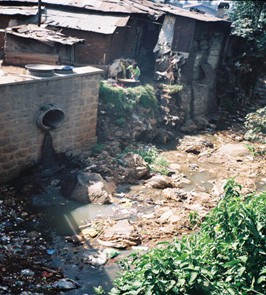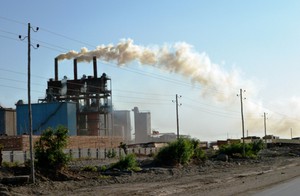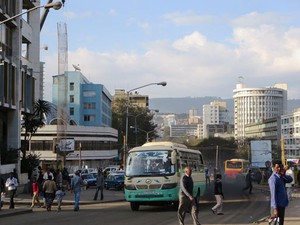Sources of pollution
Another way of classifying pollution is by the sector of human activity that produces it. Before we look at the various sectors, there is an important distinction to be made about pollution sources. Sources of pollution can be categorised as point or non-point sources. Point sources are identifiable points or places that you can easily locate. An example is a diesel truck that produces visible black exhaust fumes from its tailpipe. Liquid waste released from a pipe into a river is another example (Figure 7.4). A non-point source (also known as ‘diffuse pollution’) is one where it is difficult to identify the exact origin of the pollution. A good example is floodwater that washes all types of waste from the land (possibly including faecal matter) into a river. In this situation you cannot identify the individual or household or establishment that has caused the water pollution (Figure 7.5).

Figure 7.4 Point source: liquid waste entering a small stream.

Figure 7.5 Non-point source: solid waste and faecal matter are distributed all along the banks of the river so no single source can be identified.
Can you think of examples of point and non-point source pollution from earlier in this study session?
The farmer washing his sack is an example of a point source because you could identify where he washed his sack. However, the pesticide washing from the field is an example of a non-point source. The pollutant would wash into the river at several places, and could possibly also have come from other fields. This is an example of how difficult it can sometimes be to accurately identify the source.
Domestic sources
Domestic sources of pollution include toilets, latrines and wastewater from kitchens and bathrooms. If these wastes are properly contained and prevented from getting into the environment, they will not cause pollution. However, frequently this is not the case. Open defecation obviously releases human waste into the environment, which can then be washed into rivers and other surface waters.
What types of organic waste are produced by a typical household?
The organic wastes from domestic sources include human excreta and also food waste and other kitchen waste such as cooking oil residues.
Solid wastes from households and also from shops, markets and businesses include food waste, packaging materials and other forms of rubbish. Domestic sources are also responsible for gaseous pollutants in the form of smoke and carbon dioxide from domestic fires.
Industry
Pollution from the industrial sector in Ethiopia has been on the rise, posing a serious problem to the environment. Many industrial processes produce polluting waste substances that are discharged to the environment, frequently through chimneys (to the air) or through pipes (to surface water) (Figure 7.6). Among the most polluting industries are food processing, tanneries and textiles with processing plants and factories that produce liquid effluents which are discharged into rivers, often without treatment (Ademe and Alemayehu, 2014; Wosnie and Wondie, 2014). In practice, rivers frequently receive polluting discharges from many different sources all at the same time. The Little Akaki River in Addis Ababa, for example, is polluted by several different industrial sources as well as by domestic wastes (Tegegn, 2012).

Figure 7.6 Air pollution from an industrial source.
Agriculture
Like industry, agricultural activities are also increasing in Ethiopia, and changing too. Nowadays, agricultural activities in Ethiopia use more pesticides and fertilisers. Ethiopia imports over 3000 tons of various types of pesticides annually (Federal Environment Protection Authority, 2004). Fertiliser use in Ethiopia has increased from 140,000 metric tons in the early 1990s to around 650,000 metric tons in 2012 (Rashid et al., 2013). Fertiliser contains phosphate and nitrate and if these reach water bodies they can cause excessive plant growth (Figure 7.7).

Figure 7.7 Plant fertilisers can encourage excessive growth of vegetation if they are washed into lakes and other water bodies.
Agriculture is also responsible for gaseous pollutants in the form of methane produced by livestock and solid pollutants from crop residues, packaging materials and other wastes similar to those produced domestically. Animals also contribute to waste products and potential pollutants with their excrement.
Transport
Do you live in a city or have you visited a city close to where you live? If so you will no doubt be familiar with the variety of vehicles on our roads (Figure 7.8). Some are small cars, others are heavy motor trucks. These vehicles differ not only in their size, but also by using different types of fuel such as petrol, diesel, and blended fuel (10% ethanol and petrol). If you observe the tailpipe of diesel engine vehicles, you will have seen the black exhaust gas produced. The intensity of the black colour is greater for poorly maintained vehicles, to the extent sometimes that it makes the air hazy or smoky and causes coughs and eye irritation. The lack of a policy to remove old vehicles from the roads adds to the problem. Tiwari (2012) found that nearly a third of vehicles in Addis Ababa were over 30 years old, resulting in high levels of tailpipe emissions. Traffic jams, common in all big cities, make the problems worse.

Figure 7.8 Pollution from exhaust is worse if vehicles are poorly maintained.